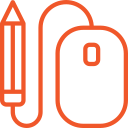3. Plagiarism
- What is plagiarism?
- What do I need to acknowledge?
- Direct quotes and paraphrasing
- Images and Creative Commons
What is plagiarism?
Charles Sturt University takes plagiarism very seriously and it is a disciplinary offence. Plagiarism is defined by the University as:
presenting someone else’s work or ideas as the student’s own, with or without their consent, by incorporating it into the student’s work without full acknowledgment. This can include published or unpublished material such as a manuscript, interactive media (video, web, audio and games), programmatic work (apps, games, web design, database design and software) and may be printed or electronic. This includes, but is not limited to, failing to acknowledge work primarily produced by a collaborator and the use of software services designed to disguise plagiarism.
There are penalties for anyone who is found guilty of plagiarism.
![]() Academic integrity is the expectation that teachers, students, researchers and all members of the academic community act with: honesty, trust, fairness, respect and responsibility. Breaching academic integrity is also known as ‘academic misconduct’.
Academic integrity is the expectation that teachers, students, researchers and all members of the academic community act with: honesty, trust, fairness, respect and responsibility. Breaching academic integrity is also known as ‘academic misconduct’.
- There is a mandatory Academic integrity subject for all Charles Sturt students.
- The Academic Integrity subject takes about 1.5 hours to complete.
- If you have not completed the Academic Integrity subject by the end of session, in line with our Academic Integrity Policy, your grades will not be visible to you.
 How to complete the subject
How to complete the subject
- Work through the Academic Integrity subject in Brightspace.
- Complete the quizzes to demonstrate your understanding.
There are five short quizzes to complete. You will need to score 80% on each quiz to demonstrate your competence.
The subject takes about 1.5 hours to complete. You do not need to complete it all at once.
In most cases, you only need to complete this subject once. However, if you receive a finding of academic misconduct, you may be required to repeat the subject.
What do I need to acknowledge?
In any assessment where you use the ideas or works of someone else, you will have to acknowledge, or reference, that other person’s work both in the body of your assignment and at the end of the assignment.
You need to acknowledge your use of other sources in your assignment with references for:
- direct quotes
- information from several sources expressed in your own words
- someone else’s ideas, even if you paraphrase them
- part or all of someone else’s design
- an image, figure, diagram or table from someone else’s work
- information from the internet, or any electronic media
- information from oral communication with others.
You do NOT need to acknowledge anything that is:
- common knowledge (either general, or specific to a certain field of study)
- your own original ideas, results of experiments and illustrations you have created
- your linking text that organises your writing and supports your ‘story’.
Visit the Referencing page for information about the referencing styles used at Charles Sturt. You should check this page before you begin your assignment so you are aware of how your references should look both in the body of your assignment and at the end of your assignment.
Direct quotes and paraphrasing
A direct quote is when you are using the exact words of an author. These words should be placed in inverted commas and the author acknowledged, such as:
“Citrus trees thrive on sunlight and require exposure to sun to grow and thrive. Also provide trees with liquid seaweed or chicken compost regularly to aid growth” (Forster, 2016, p. 2).
Paraphrasing is taking the ideas of an author and then putting those ideas in your own words. You will still need to reference the author in your work as the ideas are theirs and not your ideas. Paraphrasing the direct quote from Forster, you could write:
If you are planning to grow lemon trees make sure you plant them in a sunny spot in your garden and fertilise them monthly to help produce the best fruit (Forster, 2016, p. 2).
Check the referencing style guide for details on how to format an in-text reference for direct quotations and paraphrasing. Most styles require the author, year, and page number for direct quotations. For material without page numbers, you can provide the paragraph number or a time stamp. The APA style states that it is not required to provide a page or paragraph number for a paraphrase but you may include one to help readers find the section you are paraphrasing. You can find more information about paraphrasing, summarising and quoting in the Student Portal.
Images and Creative Commons
You must always reference images or videos that have been made by others in your assignment, as these are the intellectual property of the creator. A public copyright license, popularised by Creative Commons, allows you to use the work of others in your assignments as long as you credit the creator of the work. For more information on Creative Commons and public copyright licensing see the Find and use media module.
![]() Introduction to plagiarism (YouTube, 3m58s)
Introduction to plagiarism (YouTube, 3m58s)
Correct referencing of sources used in your assignments is essential to avoid plagiarism.
 Take careful notes of all sources of information
Take careful notes of all sources of information
Record the source of any information you find. Depending on the referencing style you use, you may need to record information such as the:
- author
- publication date
- title
- publisher
- volume
- issue
- pages
- edition
- URL etc.
![]() Academic integrity page has more information about academic integrity, academic misconduct and student conduct.
Academic integrity page has more information about academic integrity, academic misconduct and student conduct.

